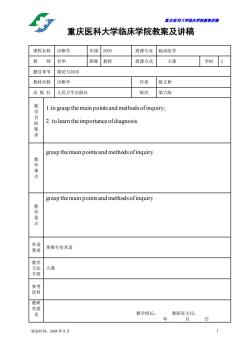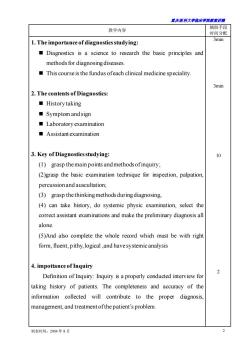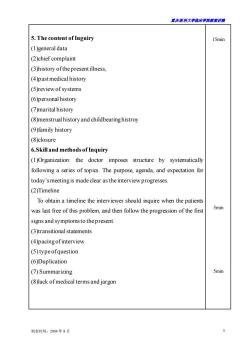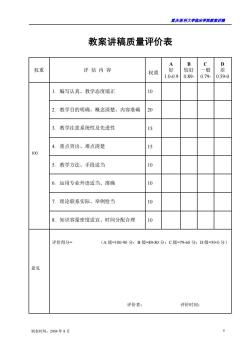重庆医科大学:《诊断学》课程教学资源(授课教案)01 绪论与问诊

置庆医科大学脑床学院讲满 重庆医科大学临床学院教案及讲稿 课程名称诊断学 年级2005 授课专业临床医学 教师甘华 职称教授 授课方式大课 学时2 题目章节绪论与问诊 教材名称诊断学 作者陈文彬 出版社人民卫生出版社 版次第六版 I.to grasp the main points and methods ofinquiry; 的要 2.to learn the importance ofdiagnosis grasp the main points and methods ofinquiry 教学难点 grasp the main points and methods ofinquiry 教学 点 外语 要求 掌握专业术语 方 大课 参考 资料 教学组长: 教研室主任: 年 制表时间:2004年8月
重庆医科大学临床学院教案讲稿 制表时间:2004 年 8 月 1 重庆医科大学临床学院教案及讲稿 课程名称 诊断学 年级 2005 授课专业 临床医学 教 师 甘华 职称 教授 授课方式 大课 学时 2 题目章节 绪论与问诊 教材名称 诊断学 作者 陈文彬 出 版 社 人民卫生出版社 版次 第六版 教 学 目 的 要 求 1.to grasp the main points and methods of inquiry; 2. to learn the importance of diagnosis. 教 学 难 点 grasp themain points and methods of inquiry. 教 学 重 点 grasp the main points and methods of inquiry 外语 要求 掌握专业术语 教学 方法 手段 大课 参考 资料 教研 室意 见 教学组长: 教研室主任: 年 月 日

露庆医科大学临床半蕊裁案讲满 教学内容 辅助手段 时间分配 1.The importance of diagnostics studying: 3min Diagnostics is a science to research the basic principles and methods for diagnosing diseases. This course is the fundus ofeach clinical medicine speciality 3min 2.The contents of Diagnostics: ■History taking ■Symptom andsign Laboratory examination Assistantexamination 3.Key of Diagnostics studying: (1)grasp the main points and methods ofinquiry; (2)grasp the basic examination technique for inspection,palpation. percussionand auscultation; (3)grasp the thinking methods during diagnosing, (4)can take history,do systemic physic examination,select the correct assistant examinations and make the preliminary diagnosis all alone. (5)And also complete the whole record which must be with right form,fluent,pithy,logical,and havesystemic analysis 4.impottance of Inquiry 2 Definition of Inquiry:Inquiry is a properly conducted interview for taking history of patients.The completeness and accuracy of the information collected will contribute to the proper diagnosis management,and treatment ofthe patient's problem. 制表时间:2004年8月
重庆医科大学临床学院教案讲稿 制表时间:2004 年 8 月 2 教学内容 辅助手段 时间分配 1. The importance of diagnostics studying: ◼ Diagnostics is a science to research the basic principles and methods for diagnosing diseases. ◼ This course is the fundus of each clinical medicine speciality. 2. The contents of Diagnostics: ◼ History taking ◼ Symptom and sign ◼ Laboratory examination ◼ Assistant examination 3. Key of Diagnosticsstudying: (1) grasp the main points and methods of inquiry; (2)grasp the basic examination technique for inspection, palpation, percussion and auscultation; (3) grasp the thinking methods during diagnosing, (4) can take history, do systemic physic examination, select the correct assistant examinations and make the preliminary diagnosis all alone. (5)And also complete the whole record which must be with right form, fluent, pithy, logical ,and have systemic analysis 4. impottance of Inquiry Definition of Inquiry: Inquiry is a properly conducted interview for taking history of patients. The completeness and accuracy of the information collected will contribute to the proper diagnosis, management, and treatment of the patient’s problem. 3min 3min 10 2

置庆医科大学床半院藏讲满 5.The content of Inguiry 15min (1)generaldata (2)chief complaint (3)history ofthe present illness, (4)past medical history (5)review ofsystems (6)personal history (7)marital history (8)menstrual history and childbearing histroy (9)family history 8)closure 6.Skill and methods of Inquiry (1)Organization:the doctor imposes structure by systematically following a series of topics.The purpose,agenda,and expectation for today's meeting is made clear as the interview progresses. (2)Timeline To obtain a timeline the interviewer should inquire when the patients was last free of this problem,and then follow the progression of the first 5min signs and symptoms to the present (3)transitional statements (4)pacing ofinterview (5)typeofquestion (6)Duplication (7)Summarizing 5min (8)lack ofmedical terms and jargon 制表时间:2004年8月
重庆医科大学临床学院教案讲稿 制表时间:2004 年 8 月 3 5. The content of Inguiry (1)general data (2)chief complaint (3)history of the present illness, (4)past medical history (5)review of systems (6)personal history (7)marital history (8)menstrual history and childbearing histroy (9)family history (8)closure 6.Skill and methods of Inquiry (1)Organization: the doctor imposes structure by systematically following a series of topics. The purpose, agenda, and expectation for today’s meeting is made clear as the interview progresses. (2)Timeline To obtain a timeline the interviewer should inquire when the patients was last free of this problem, and then follow the progression of the first signs and symptoms to the present. (3)transitional statements (4)pacing of interview (5) type of question (6)Duplication (7) Summarizing (8)lack of medical terms and jargon 15min 5min 5min

君庆医科大学脑床半院表来讲测 The importance of diagnostics studying 2 The contents of Diagnostics Key of Diagnostics studying 4.impottance of Inquiry 5.The content of Inguiry 小结 6.Skill and methods of Inquiry 1.What are the Skill and methods of Inquiry? 制表时间:2004年8月
重庆医科大学临床学院教案讲稿 制表时间:2004 年 8 月 4 小结 1.The importance of diagnostics studying 2.The contents of Diagnostics 3.Key of Diagnostics studying 4.impottance of Inquiry 5.The content of Inguiry 6. Skill and methods of Inquiry 思考 题及 预习 1.What are the Skill and methods of Inquiry?

重庆医科大半临床半院载案讲满 教案讲稿质量评价表 D 权重 评估内容 较好 船 权重 1.0-0.90.8 0.79- 0.59-0 编写认真、教学态度端正 教学目的明确、概念清楚、内容准确 20 3.教学注意系统性及先进性 15 4. 重点突出、难点清楚 15 100 5. 教学方法、手段适当 6. 运用专业外语适当、准确 10 理论联系实际、举例恰当 10 8.知识容量密度适宜、时间分配合理 评价得分 (A级=100-90分:B级=89-80分: C级=79-60分:D级=59-0分) 意见 评价者: 评价时间: 制表时间:2004年8月
重庆医科大学临床学院教案讲稿 制表时间:2004 年 8 月 5 教案讲稿质量评价表 权重 评 估 内 容 权重 A 好 1.0-0.9 B 较好 0.89- C 一般 0.79- D 差 0.59-0 100 1. 编写认真、教学态度端正 10 2. 教学目的明确、概念清楚、内容准确 20 3. 教学注意系统性及先进性 15 4. 重点突出、难点清楚 15 5. 教学方法、手段适当 10 6. 运用专业外语适当、准确 10 7. 理论联系实际、举例恰当 10 8. 知识容量密度适宜、时间分配合理 10 意见 评价得分= (A 级=100-90 分;B 级=89-80 分;C 级=79-60 分;D 级=59-0 分) 评价者: 评价时间:
按次数下载不扣除下载券;
注册用户24小时内重复下载只扣除一次;
顺序:VIP每日次数-->可用次数-->下载券;
- 重庆医科大学:《诊断学》课程教学资源(授课教案)08 腹部检查.doc
- 重庆医科大学:《诊断学》课程教学资源(授课教案)09 病历与诊断.doc
- 重庆医科大学:《诊断学》课程教学资源(授课教案)03 呕血.doc
- 重庆医科大学:《诊断学》课程教学资源(授课教案)04 便血.doc
- 重庆医科大学:《实验诊断学》课程教学资源(PPT课件)第八讲 脑脊液常规及生殖系统检查.ppt
- 重庆医科大学:《实验诊断学》课程教学资源(PPT课件)第七讲 大便常规、免疫学检查及心肌标志物检查.ppt
- 重庆医科大学:《实验诊断学》课程教学资源(PPT课件)第六讲 肾功能检查(主讲:唐敏).ppt
- 重庆医科大学:《实验诊断学》课程教学资源(PPT课件)第四讲 血栓与出血检查(主讲:胥文春).ppt
- 重庆医科大学:《实验诊断学》课程教学资源(PPT课件)第三讲 骨髓细胞学检查、血型与输血.ppt
- 重庆医科大学:《实验诊断学》课程教学资源(PPT课件)第一讲 总论及血液一般检查(上).ppt
- 上海科学技术出版社:《实验诊断学——彩色图谱》书籍PDF电子版(主编:张丽霞、陈金宝).pdf
- 重庆医科大学:《实验诊断学》课程复习题集(无答案).doc
- 《实验诊断学》课程实验指导书 laboatoty diagnosis(共九章,含练习及答案).doc
- 重庆医科大学:《实验诊断学》课程教学资源(教案)第8讲 CSF生殖系统.doc
- 重庆医科大学:《实验诊断学》课程教学资源(教案)第7讲 大便 免疫 心肌.doc
- 重庆医科大学:《实验诊断学》课程教学资源(教案)第6讲 肾功能.doc
- 重庆医科大学:《实验诊断学》课程教学资源(教案)第2讲 血液(下).doc
- 重庆医科大学:《实验诊断学》课程实验教学大纲(供临床医学专业本科用).doc
- 重庆医科大学:《实验诊断学》课程理论教学大纲(供五年制临床医学、儿科医学、预防医学、麻醉医学、影像医学专业本科使用).doc
- 石河子大学:《妇产科护理学》课程教学课件(PPT讲稿)第四章 妊娠期妇女的护理.ppt
- 重庆医科大学:《诊断学》课程教学资源(授课教案)02 水肿.doc
- 重庆医科大学:《诊断学》课程教学资源(授课教案)07 黄疸.doc
- 重庆医科大学:《诊断学》课程教学资源(授课教案)05 腹痛.doc
- 重庆医科大学:《诊断学》课程教学资源(授课教案)06 腹泻.doc
- 重庆医科大学:《诊断学》课程教学资源(授课教案)14 心电图.doc
- 重庆医科大学:《诊断学》课程教学资源(授课教案)11 心脏检查.doc
- 重庆医科大学:《诊断学》课程教学资源(授课教案)20 呼吸系统症状和体征.doc
- 重庆医科大学:《诊断学》课程教学资源(授课教案)13 循环系统主要症状与体征.doc
- 重庆医科大学:《诊断学》课程教学资源(授课教案)15 超声心动图检查.doc
- 重庆医科大学:《诊断学》课程教学资源(授课教案)12 血管检查.doc
- 重庆医科大学:《诊断学》课程教学资源(授课教案)10 发热.doc
- 重庆医科大学:《诊断学》课程教学资源(授课教案)19 胸部检查.doc
- 重庆医科大学:《诊断学》课程教学资源(授课教案)18 呼吸困难.doc
- 重庆医科大学:《诊断学》课程教学资源(授课教案)16 咳嗽、咳痰.doc
- 重庆医科大学:《诊断学》课程教学资源(授课教案)17 咯血.doc
- 医学临床本科《MRI诊断学》课程教学大纲 Magnetic Resonance Imaging Diagnosis.doc
- 医学临床本科《影像诊断学》课程教学大纲 medical imaging(包含MRI部分).doc
- 医学影像本科《MRI诊断学》课程教学大纲(Magnetic Resonance Imaging Diagnosis).doc
- 石河子大学:《MRI诊断学》课程教学资源(讲稿,共五章).doc
- 石河子大学:《MRI诊断学》课程教学课件(PPT讲稿)第一章 MRI总论.ppt
